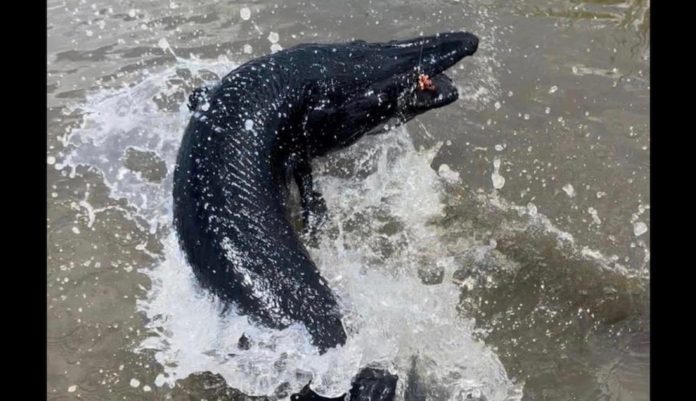A Texas angler received a major surprise last week when he hooked a rare black alligator gar while casting a fly designed to catch redfish.
“It was very surprising once the fish surfaced to see that it was jet black, which I had never seen in all of the alligator gar I had seen,” Justin Jordan, owner of Lotus Guide Service, told FTW Outdoors.
Jordan and Terrell Maguire were fishing from a skiff in southeast Texas when they spotted a dark figure moving across the marsh. Jordan identified the 5-foot-long fish as a melanistic alligator gar, which went after Maguire’s fly moments after it had landed on the surface.
Photo: Lotus Guide Service
“We landed it, but I didn’t want to put it in my boat because they stink,” Jordan said of a prehistoric fish species that dates back 100 million years. (Gars are often referred to as “living fossils.”)
ALSO: Anglers cited for catching 100-plus crappie over the legal limit
Jordan shared images to Facebook on May 16, showing the gar half out of the water trying to shake the hook.
“Well… me and Terrell found out melanistic gar do exist yesterday,” he wrote.
Alligator gar are torpedo-shaped predators with toothy jaws and snouts that resemble those of alligators. They can measure 10 feet and weigh nearly 300 pounds.

Poto: Lotus Guide Service
The all-tackle world record, a 279-pound alligator gar caught in the Rio Grande, Texas, has stood since 1951.
The fish are typically olive-colored. Melanistic gar, whose skin contains an abnormally high level of a pigment called melanin, are rarely seen or caught.
And while alligator gar are popular among sport anglers, mostly because of their size and strength, their flesh is not highly regarded as table fare.
Jordan said the melanistic gar attacked a crab-like fly called a “spork,” made by his friend and fellow captain, Collin Scoville.
“It was definitely the wrong fly for gar,” Jordan said. “And it’s kind of an ongoing joke because the ‘spork’ fly literally has caught almost every game species in the Gulf Coast marsh.”
Credit: Source link































